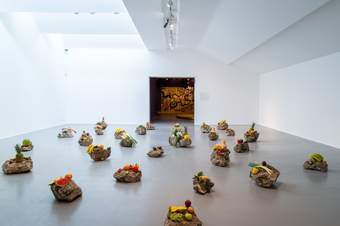
Edgar Calel, Ru k’ox k’ob’el jun ojer etemab’el (The Echo of an Ancient Form of Knowledge), 2021. Liverpool Biennial 2023 at Tate Liverpool. Courtesy of Liverpool Biennial. Photography by Mark McNulty.

Edgar Calel, Ru k’ox k’ob’el jun ojer etemab’el (The Echo of an Ancient Form of Knowledge), 2021. Liverpool Biennial 2023 at Tate Liverpool. Courtesy of Liverpool Biennial. Photography by Mark McNulty.
Tate has officially become custodian of The Echo of an Ancient Form of Knowledge (2021) by Maya-Kaqchikel artist Edgar Calel (b.1987, Guatemala) in a first for the institution. Rather than owning the work outright, the artist and Proyectos Ultravioleta shaped the model of custodianship, enabling Tate to push the boundaries of how museum collections traditionally operate. Tate will instead be its custodian for the next 13 years, with the start of this custodianship being marked by a ritual ceremony performed by the artist during preparations for the work’s inaugural display as part of this year’s Liverpool Biennial (uMoya: The Sacred Return of Lost Things). Visitors will be able to view The Echo of an Ancient Form of Knowledge (2021) at Tate Liverpool until 17 September 2023.
Calel’s work is both a material object and a ritual, which serves as a container of ancestral knowledge. It comprises a range of fruits and vegetables placed as offerings to the artist’s ancestors upon large rocks arranged on the gallery floor. Each rock represents an altar related to the story of Wuqub’ Kaqix – a deity who takes the form of part human, part bird – from the sacred Mayan book of creation. A ritual is performed on the fruit by a member of the artist’s Maya-Kaqchikel community in order to bless it and allow it to transcend into the spiritual realm. Through this process, Calel encourages viewers to consider the complexities of indigenous communities whose culture, language and lands are under threat.
The agreement between Tate and the artist is based on Mayan thinking and custom. Recognising that Calel’s work is more than just physical form, the custodianship pays homage to the local indigenous communities within Guatemala and acknowledges the importance of sharing knowledge with the Maya-Kaqchikel people. The custodianship period of 13 years is significant as the number represents a sacred cycle of time in the Mayan calendar. At the end of the 13 years, a new agreement will be made with the artist and his community, either to renew Tate’s custodianship, to pass it on to another institution, or to return the elements of the work to the earth.
Edgar Calel said: “These stones are not just stones. These fruits are not just fruits. Together they form altars and become a sacred site for rituals. When placing a fruit or a vegetable atop a stone with the proper intention, these elements become an offering to our ancestors and the land, and a way to thank them for their wisdom, experiences, and guidance.
“We offer fruits with different flavors, colors, and textures, and to them we bring a little beverage to calm their thirst. Along with this we also bring the smell of incense to expand into infinity so they feel the aroma of these offerings.
“In this way, we can thank here and there the grandmothers and grandfathers who inhabit the dimension of immateriality. The same ones who are now in the particles of dust and the grains of sand, the same ones who have clear knowledge and white hair.
“All this is a way to say: thank you for the knowledge and wisdom that they left to our people and we keep in our hearts with much respect and love.”
Gregor Muir, Tate’s Director of Collection, International Art, said: “Acquired for the collection in 2021, Edgar Calel’s installation fascinated us from the get go. Functioning like altarpieces on which we see sacrificial fruits and vegetables, his arrangement of rocks with all their associated rituals challenge the very concept of what it is to own something. The work purposely asks us to redefine collecting through a custodial agreement whereby the Tate retains a direct line to the artist and the Maya community. While we can never own Calel’s installation, we have much to learn from its intrinsic questioning.”